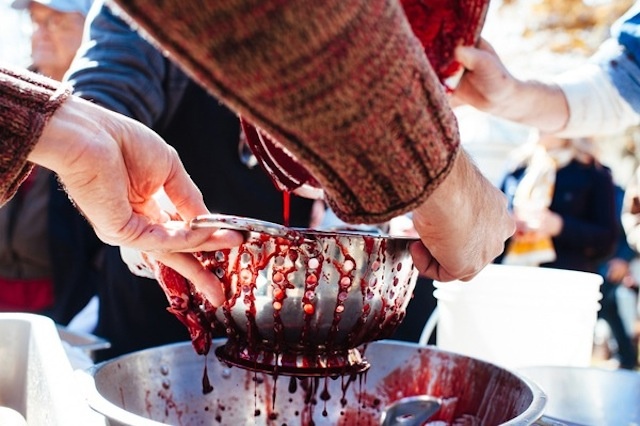
The author in one of her first test shoots. She was 19 and 115 pounds. Photo by Michelle Ricks.
This week in New York City, hundreds of young girls will hit the runway for fashion week, the modeling world’s holiest and most competitive grail. Although participating in New York Fashion Week sounds glamorous, the lifestyle that some of these girls are engaged in—never sleeping, never eating, traveling endlessly, and constantly being judged and objectified—can be a catalyst for poor mental health.
In the past decade, at least 20 models have committed suicide—some famous, some not—and there are likely many more lesser-known models whose attempts may have gone completely unreported. According to a 2012 study done by the Model Alliance, a non-profit labor advocacy group where I work as a graphic designer, 68.3 percent of models admit to suffering from depression or anxiety. For several years of my life, I was one of those women.
I started modeling professionally at the age of 19, when I was in college. I was suckered into signing with a small boutique agency in San Diego in the summer of 2007. Having grown-up in a tiny suburb of San Diego misguidedly obsessing over shows like America’s Next Top Model, the opportunity to model and travel for free seemed like a no-brainer. But before my agency would allow me to sign the dotted line on my first contract, they wrapped a measuring tape over my jeans. You see, models aren’t measured in pounds, they’re measured in inches. I had to lose two inches, or roughly 15 pounds, all over my body to land the contract.
At 5 feet 9 inches, 135 pounds, and a size six, I didn’t really understand. I was tall and skinny. What did it matter if I had 37-inch hips? Yet, when my agent handed me a list of foods I could and could not eat, I said, “Yes.” On the list: chicken, fish, steamed vegetables, and other sources of lean protein, like almonds and eggs. Pretty much every other kind of food item (especially bread) was off-limits. As a 19-year-old whose concept of nutrition went as far as her university’s dining hall, I didn’t understand that 800 calories a day countered by two hours of exercise was a starvation diet, something capable of doing long-term damage to my metabolism. I lost 20 pounds in seven weeks, going from a size six to a size two—a drastic weight loss, which terrified my family and delighted my agent. Miserable and frail, I was promptly sent to work in New York City.
In New York, the weight became a struggle to keep off, but new jobs and praise from my agency made me think it was worth it. “You’re so skinny,” my roommates would coo, as we cooked vegetable “fajitas” (vegetables, water, and corn tortillas) on our budget stove. I binged at free dinners provided by promoters and punished myself afterwards by not eating for days. I would walk miles around the city for hours on end just to burn off any food I'd ingested. Eventually, when school started again, I took another semester off to travel abroad on a potential modeling contract in Korea—which didn’t happen, because I gained a few pounds, causing my agency to treat me like I’d committed an awful crime. “What happened to you,” my agent gasped as I walked into her office a few pounds heavier, already mentally drafting a cancellation letter to the agency who’d expressed interest in me in Seoul.
As a model in New York, I never did anything notable. No shoots with Nick Knight or walking in an Alexander Wang runway show. Instead, I did shoots for prom catalogues and book covers, making a little bit of money with a mid-level commercial agency. But that dream of glamorous success that only a small fraction of girls ever experience was the literal and metaphorical carrot my agent in San Diego dangled in front of me every time I considered quitting the industry. It took me years to realize how unhappy I was. Ultimately, I had to see a therapist when I moved back home, something my family still doesn’t know about to this day (thanks to my university’s free health resources). She helped me recover and craft a newfound self-identity beyond my weight and my looks.
I know that everyone’s experience isn’t like my own, but it’s important for all the would-be models out there to understand that the industry as it is today can be a breeding ground for psychological illness and there are very few resources to counteract that. Many of the friends I had in my modeling days suffered similar kinds of damage.

Laurel on February 2009 at Vena Cava, fall/winter 2010.
Earlier this week over a Skype call, I was discussing these issues with Laurel Stovall, a 27-year-old model and close friend of mine who I connected with years ago online after stumbling upon her style blog, which sometimes covers the modeling world. It was on this call that she opened up to me for the first time and made me realize we really weren’t that different.
Laurel was 23 and suffering from a severe eating disorder when she was discovered by an agent from Ford modeling agency in 2010. Before she even became a professional model, she was dangerously skinny, weighing 116 pounds at 5 feet 11 inches. The day the agent approached her, she told me she was the sickest and saddest she’d ever been.
“And the agent, she just looked at me and said, 'Are you signed?'” Laurel explained.
At the time she was discovered, she was getting ready to seek professional help, but then her disorder was validated by the excitement of a modeling contract, followed by high profile bookings in New York and Milan. It was a sick cycle of validation that made her feel like she was doing the right thing by starving herself.
“Everyone around you tells you how lucky you are, every single fucking day. And you know what? Sometimes, you are,” she said to me last week. “I didn’t know any better. I thought it was cool. I was getting out of my hometown of Reno... Yet I felt like garbage all the time.”
Laurel signed with New York Models, a top agency in the city, coming within an inch of booking Calvin Klein—one of fashion week’s most prestigious shows.
“I was actually on exclusive twice, but [show coordinators from Calvin Klein] called my agency and told them I was too thin. My agent told me to just go home and eat nothing but peanut butter for two weeks. This is how you guys think you’re going to solve the problem? Peanut butter?”
Today, like me, Laurel has left high fashion world of NYC behind, and instead does more commercial work in LA, where she can be a size six and still get work. She’s also turning a new page in her life beyond the confines of the industry and is applying to grad school with plans to work in politics.
“When I tell people I wasn’t really happy as a model and I was looking to change that, they were shocked.” Laurel said. “I couldn’t deal with such an utter lack of control. It’s so empowering to realize I can control it—that I can change things, that this is my life.”

Laurel looking healthy in LA in summer of 2013.
One of the biggest reasons for stories like mine and Laurel’s is the complete lack of regulation in the modeling industry. There is no regulatory body for agencies because models are independent contractors, yet they are booked for jobs exclusively by an agency who takes commission. Basically, you’re a freelancer who can’t actually freelance. Not to mention, models are usually insurance-less, making mental health resources hard to come by. Models can’t even sue employers for sexual harassment, because they are not technically employees. This environment breeds a sense of instability perpetuated by agencies who act as employers but refuse to take responsibility for basic labor rights, such as timely payment, health insurance, and protection from sexually-abusive clients.
“For those in the modeling industry facing the pressures to strive for, and engage in behaviors to achieve thinness in order to work, a vulnerability to developing an eating disorder may be triggered,” said Susie Roman, Program Director at the National Eating Disorders Affiliation. “Given that models do not have much power to advocate for being at one’s own healthy weight and still get work, change within in the industry is needed.”
.jpg)
The author on the far left, looking healthy, with the Model Alliance team.
This change may soon happen thanks to the Model Alliance, the organization I work for today. It was founded by model and filmmaker Sara Ziff, who shed light on the industry with her 2009 documentary Picture Me. I joined their team in April of 2011, and since then, we’ve accomplished amazing things, such as passing a New York Law to afford models under 18 more protections. This fashion week will be the first time it goes into effect, forcing designers to make sure models under 18 have work permits, trust funds, and more in place before they even attend a fitting. We also introduced a healthcare partnership with the Retail Action Project, so models seeking psychological help will have access to affordable mental care.
It’s been eight years since my days of starving myself in New York City. I wish I could say that eating disorders can completely go away, that being handed a list of things not to think could reverse the damage that happened in me when I was given a list of what not to eat. But anyone who’s suffered from a disorder knows that they still appear from time to time. For me, it happens when a friend jokingly asks how much I weigh or a guy I’m with lovingly calls me curvy. Fortunately, I am now in a place mentally where I can fight against those thoughts. And at 27, I am actually grateful for my failed career as a model, because it gave me the insight on how to assist other women who truly need support. If telling my story can help just a handful of the girls that will be storming down the runways this week, then it was certainly worth it.
If you or someone you know suffers from depression, anxiety, or eating disorders, we urge you to seek help from a qualified medical practitioner. The National Alliance on Mental Illness is a great resource for starters. If you're a model, you can find assistance from the good people at Model Alliance.








































